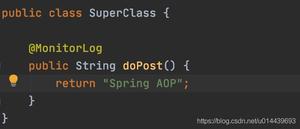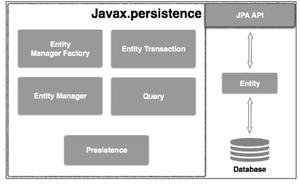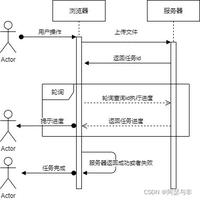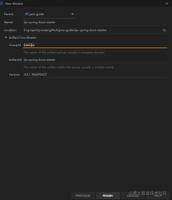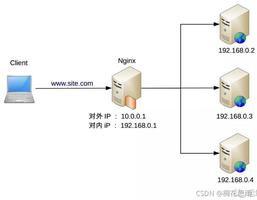基于spring注解AOP的异常处理
本文内容纲要:
- 一、前言- 二、基于@ControllerAdvice(加强的控制器)的异常处理
- 三、基于AOP的异常处理
- 四、疑惑
- 五、测试
一、前言
项目刚刚开发的时候,并没有做好充足的准备。开发到一定程度的时候才会想到还有一些问题没有解决。就比如今天我要说的一个问题:异常的处理。写程序的时候一般都会通过try...catch...finally对异常进行处理,但是我们真的能在写程序的时候处理掉所有可能发生的异常吗? 以及发生异常的时候执行什么逻辑,返回什么提示信息,跳转到什么页面,这些都是要考虑到的。
二、基于@ControllerAdvice(加强的控制器)的异常处理
参考文档:http://jinnianshilongnian.iteye.com/blog/1866350
@ControllerAdvice注解内部使用@ExceptionHandler、@InitBinder、@ModelAttribute注解的方法应用到所有的 @RequestMapping注解的方法。本例子中使用ExceptionHandler应用到所有@RequestMapping注解的方法,处理发生的异常。
示例代码:
import org.slf4j.Logger;import org.slf4j.LoggerFactory;
import org.springframework.http.HttpHeaders;
import org.springframework.http.HttpStatus;
import org.springframework.http.ResponseEntity;
import org.springframework.util.StringUtils;
import org.springframework.web.bind.annotation.ControllerAdvice;
import org.springframework.web.bind.annotation.ExceptionHandler;
import org.springframework.web.bind.annotation.ResponseBody;
import com.hjz.exception.ServiceException;
import com.hjz.exception.utils.ExceptionUtils;
@ResponseBody
public class ExceptionAdvice {
private static final Logger LOGGER = LoggerFactory.getLogger(ExceptionAdvice.class);
/**
* 拦截web层异常,记录异常日志,并返回友好信息到前端
* 目前只拦截Exception,是否要拦截Error需再做考虑
*
* @param e 异常对象
* @return 异常提示
*/
@ExceptionHandler(Exception.class)
public ResponseEntity<String> handleException(Exception e) {
//不需要再记录ServiceException,因为在service异常切面中已经记录过
if (!(e instanceof ServiceException)) {
LOGGER.error(ExceptionUtils.getExcTrace(e));
}
HttpHeaders headers = new HttpHeaders();
headers.set("Content-type", "text/plain;charset=UTF-8");
headers.add("icop-content-type", "exception");
String message = StringUtils.isEmpty(e.getMessage()) ? "系统异常!!" : e.getMessage();
return new ResponseEntity<>(message, headers, HttpStatus.OK);
}
}
如果不起作用,请检查 spring-mvc的配置文件,是否有ControllerAdvice的如下配置
<context:component-scan base-package="com.xxx.xx" use-default-filters="false"> <context:include-filter type="annotation" expression="org.springframework.stereotype.Controller"/>
<context:include-filter type="annotation" expression="org.springframework.web.bind.annotation.ControllerAdvice"/>
</context:component-scan>
附上:Spring MVC的Controller统一异常处理:HandlerExceptionResolver
三、基于AOP的异常处理
1.处理controller层的异常 WebExceptionAspect.java
import org.aspectj.lang.annotation.AfterThrowing;import org.aspectj.lang.annotation.Aspect;
import org.aspectj.lang.annotation.Pointcut;
import org.slf4j.Logger;
import org.slf4j.LoggerFactory;
import org.springframework.stereotype.Component;
import org.springframework.util.StringUtils;
import org.springframework.web.context.request.RequestContextHolder;
import org.springframework.web.context.request.ServletRequestAttributes;
import com.hjz.exception.ServiceException;
import com.hjz.exception.utils.ExceptionUtils;
import javax.servlet.http.HttpServletResponse;
import java.io.IOException;
import java.io.PrintWriter;
/**
* web异常切面
* 默认spring aop不会拦截controller层,使用该类需要在spring公共配置文件中注入改bean,
* 另外需要配置<aop:aspectj-autoproxy proxy-target-class="true"/>
*/
@Aspect
public class WebExceptionAspect {
private static final Logger LOGGER = LoggerFactory.getLogger(WebExceptionAspect.class);
@Pointcut("@annotation(org.springframework.web.bind.annotation.RequestMapping)")
private void webPointcut() {}
/**
* 拦截web层异常,记录异常日志,并返回友好信息到前端
* 目前只拦截Exception,是否要拦截Error需再做考虑
*
* @param e 异常对象
*/
@AfterThrowing(pointcut = "webPointcut()", throwing = "e")
public void handleThrowing(Exception e) {
//不需要再记录ServiceException,因为在service异常切面中已经记录过
if (!(e instanceof ServiceException)) {
LOGGER.error(ExceptionUtils.getExcTrace(e));
}
String errorMsg = StringUtils.isEmpty(e.getMessage()) ? "系统异常" : e.getMessage();
writeContent(errorMsg);
}
/**
* 将内容输出到浏览器
*
* @param content 输出内容
*/
private void writeContent(String content) {
HttpServletResponse response = ((ServletRequestAttributes) RequestContextHolder.getRequestAttributes()).getResponse();
response.reset();
response.setCharacterEncoding("UTF-8");
response.setHeader("Content-Type", "text/plain;charset=UTF-8");
response.setHeader("icop-content-type", "exception");
PrintWriter writer = null;
try {
writer = response.getWriter();
} catch (IOException e) {
e.printStackTrace();
}
writer.print(content);
writer.flush();
writer.close();
}
}
2.处理service层的异常ServiceExceptionAspect .java
import org.aspectj.lang.JoinPoint;import org.aspectj.lang.annotation.AfterThrowing;
import org.aspectj.lang.annotation.Aspect;
import org.aspectj.lang.annotation.Pointcut;
import org.slf4j.Logger;
import org.slf4j.LoggerFactory;
import org.springframework.stereotype.Component;
import org.springframework.util.StringUtils;
import com.hjz.exception.ServiceException;
import com.hjz.exception.utils.ExceptionUtils;
@Aspect
public class ServiceExceptionAspect {
private static final Logger LOGGER = LoggerFactory.getLogger(ServiceExceptionAspect.class);
/**
* @within(org.springframework.stereotype.Service),拦截带有 @Service 注解的类的所有方法
* @annotation(org.springframework.web.bind.annotation.RequestMapping),拦截带有@RquestMapping的注解方法
*/
@Pointcut("@within(org.springframework.stereotype.Service) && execution(public * *(..))")
private void servicePointcut() {}
/**
* 拦截service层异常,记录异常日志,并设置对应的异常信息
* 目前只拦截Exception,是否要拦截Error需再做考虑
*
* @param e 异常对象
*/
@AfterThrowing(pointcut = "servicePointcut()", throwing = "e")
public void handle(JoinPoint point, Exception e) {
LOGGER.error(ExceptionUtils.getExcTrace(e));
String signature = point.getSignature().toString();
String errorMsg = getMessage(signature) == null ? (StringUtils.isEmpty(e.getMessage()) ? "服务异常" : e.getMessage()) : getMessage(signature);
throw new ServiceException(errorMsg, e);
}
/**
* 获取方法签名对应的提示消息
*
* @param signature 方法签名
* @return 提示消息
*/
private String getMessage(String signature) {
return null;
}
}
3.使用方式,在spring的公共配置文件中加入如下配置:
<aop:aspectj-autoproxy proxy-target-class="true" /><bean class="com.hjz.exception.aspect.ServiceExceptionAspect" />
<bean class="com.hjz.exception.aspect.WebExceptionAspect" />
或者 自定义一个 注册类,ServiceExceptionAspect.java和WebExceptionAspect.java都加入@Component注解
import org.springframework.context.annotation.ComponentScan;import org.springframework.context.annotation.Configuration;
import org.springframework.context.annotation.EnableAspectJAutoProxy;
/**
* 异常相关bean注册类
*/
@Configuration
@EnableAspectJAutoProxy
@ComponentScan("com.hjz.exception.aspect")
public class ExceptionConfig {
}
注:spring 公共配置文件中的配置 改成
@Aspect@Component
public class WebExceptionAspect {
..........
}
@Aspect
@Component
public class ServiceExceptionAspect {
.........
}
四、疑惑
@within(org.springframework.stereotype.Service),拦截带有 @Service 注解的类的所有方法
** @annotation(org.springframework.web.bind.annotation.RequestMapping),拦截带有@RquestMapping的注解方法**
五、测试
分别编写controller层和service层的异常测试类。这个很简单,在方法里简单的抛一下异常就可以了。最后验证一下,异常发生的时候有没有 执行 @AfterThrowing对应的方法就好了。具体还是看我写的demo吧,嘿嘿嘿!!!
完整项目下载地址:https://github.com/hjzgg/Spring-annotation-AOP-Exception_handling
本文内容总结:一、前言,二、基于@ControllerAdvice(加强的控制器)的异常处理,三、基于AOP的异常处理,四、疑惑,五、测试,
原文链接:https://www.cnblogs.com/hujunzheng/p/6255463.html
以上是 基于spring注解AOP的异常处理 的全部内容, 来源链接: utcz.com/z/296880.html


